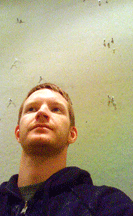
|
Volume 16, Issue 50 - December 11 - December 17, 2008
|
|
Columns |
Water in His Eyes
From Annapolis, Matt Braun has taken a seat at the Philadelphia Museum of Art
by Sandra Olivetti Martin
Water got in Matt Braun’s eyes: its spectrum range from blue through green, its sinuous motion, its explosive force. Ocean water got in Braun’s eyes as a kid on North Carolina beaches.
Chesapeake water got in his eyes as a skateboarding Annapolis High Schooler, here from 1994 to 1996 to live with his brother.
Water stayed in his eyes in Philadelphia, where he’s been a hip DJ and off-and-on art student since the late 1990s.
Water got in Braun’s eyes, and stayed. So water is what the 30-year-old University of the Arts industrial design student saw when he imagined what he’d make to win the Philadelphia Museum of Art Student Competition.
Braun’s challenge was how to make water hold a sitting person or two.
He beat the challenge by turning water into glass — a solution so good it won second prize in an art competition in a city that thrives on art.
In glass lay the second part of Braun’s challenge.
The competition brief, Braun told Bay Weekly, was to make a quarter-scale model of a bench in the spirit of architect and industrial designer Frank Gehry — for a building Gehry designed.
Gehry is what’s called a Deconstructivist Post-Modern architect. He designs buildings and what goes inside them, and all of it looks more like the work of forces of nature — rockslides and lightning bolts — than traditional buildings and furniture.
Gehry designed the new Guggenheim Museum in Bilbao, Spain, and proposed another Guggenheim for New York, to be set on a pier on the East River. That imagined museum is where Braun imagined his competition bench.
In form, Braun said, “it was directly influenced by water and the way Gehry’s buildings have a sense of flow and movement.”
In material, he said, he wondered “what would Frank do?”
“The thing that’s never been done before,” was his answer — and his vision.
“Slumped glass on that scale had never been done before,” Braun said. Though — ah, the synchronicity of it — “Gehry was the first to use slumped glass in watery shapes” for furniture.
Slumped glass is sheet glass heated in a kiln until it melts into the shape of the mold it rests on.
Thus was imagined Braun’s 17-inch-high, eight-foot-long bench. Imagined, but not born. The prize-winning quarter-scale model is Plexiglas. Creating one of the real thing would cost $100,000.
Will it ever happen?
“I’d love to see it actualized, and I have real hope of getting it produced,” Braun said.
But high-end, high-scale design — the sort of work that has made Frank Gehry a wealthy international celebrity — is not where Matt Braun sees his future.
“People get caught up in making really expensive things that cater to 10 or 15 percent of the world population,” Braun said. He’s looking to the other end of the spectrum of industrial design. At the same time, he’s still seeing water.
“The 90 percent left out are often people suffering and dying. My long-term goal is to help develop the infrastructure to get electricity or drinking water to people who need it.
“For somebody like me who has the knowledge,” the young designer said, “it would be a catastrophe not to use it.”